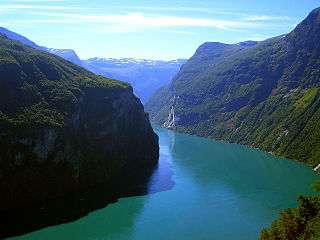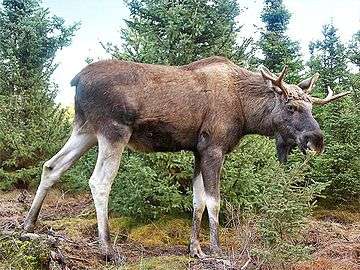Nordic countries
The Nordic countries make up the northernmost part of western Europe, extending into the Arctic. They include Finland, Iceland, Norway, Sweden, and Denmark, the Faroe Islands, Åland and in most definitions Greenland, as there are long-standing political and linguistic ties.
These neighbours share a common heritage dating back at least to the Viking Age, with several unions in the past and close cooperation today. At almost 1.2 million square kilometres (463,000 square miles), the Nordic countries form one of the largest regions in Europe, but are home to only around 24 million people, accounting for a mere 4% of its population. The Nordic countries contain some of Europe's greatest natural wonders, and boast an excellent standard of living.
Countries
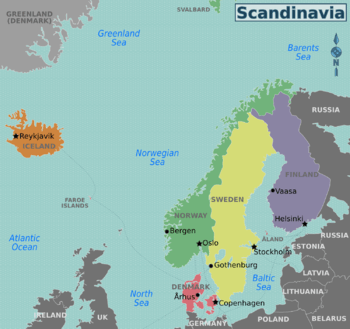
| Denmark The smallest Nordic country features hundreds of islands, rolling farmland, endless beaches and a more continental vibe. |
| Norway (including Svalbard) Famous for deep fjords, steep mountains, countless waterfalls, wooden churches, the Northern Lights and millennial maritime traditions. Norway's topology and nature have distinctive regional diversity. |
| Sweden The largest Nordic country by area and population is home to endless forests, clear blue lakes and the beautiful archipelagos along its coasts. |
| Finland Hundreds of thousands of islands and lakes to explore in this bridge to the east. The most sparsely populated EU country, and the only Nordic country to use the euro, with a Nordic tongue the first language only of a minority. |
| Iceland Spectacular scenery of volcanoes, glaciers, geysers, and waterfalls on this North Atlantic island. |
| Åland An archipelago and autonomous territory of Finland in the Baltic Sea, where the Swedish-speaking population has its own distinctive culture and sense of quasi-national identity. |
| Faroe Islands An autonomous territory of Denmark in the Atlantic Ocean with a very distinct culture and sense of national identity. Especially known for its dramatic natural scenery and unique bird life. |
- Greenland is an autonomous territory of Denmark; geographically part of North America. The indigenous people, the Inuit, are also culturally close to native America, but there is a strong modern Nordic influence.
- While the Baltic states have much common history with the Nordic countries, and especially Estonians claim their country to be Nordic, they are not members of the Nordic Council and they are covered by a separate region on Wikivoyage.
Cities
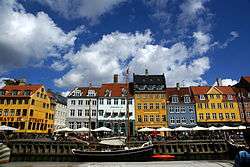
- 🌍 Aarhus — a brilliant Open Air Museum containing historic buildings from towns and cities across Denmark, many from the 1800s
- 🌍 Bergen — old Hanseatic trading centre with wonderfully cute wooden buildings, a magnificent mountain setting, varied nightlife and tons of atmosphere
- 🌍 Copenhagen — a vast number of offers for cultural experiences, shopping and the inspiration of Danish design traditions. Lately it has become the gastronomical centre of the region, driving the principles of "New Nordic Cuisine" with many great restaurants and bars as a result.
- 🌍 Gothenburg — a port and industrial city on the Swedish west coast, second in size in Sweden
- 🌍 Helsinki — the "Daughter of the Baltic", Finland's capital and largest city with its iconic cathedral
- 🌍 Oslo — museums of national importance, a beautiful setting, lively nightlife and cultural scene
- 🌍 Reykjavík — the northernmost national capital in the world
- 🌍 Stockholm — spread out over a number of islands, one of the most beautiful cities of Scandinavia
- 🌍 Turku — the gateway to the Archipelago Sea; the huge Castle and Cathedral are the two poles of historic Turku, between which just about every important site in the city can be found
Other destinations
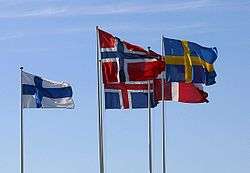
- 🌍 Gotland — the largest island in the Baltic Sea, with the UNESCO heritage main town of Visby and great partying in the summer
- 🌍 Jostedalsbreen — the largest glacier on the European mainland
- 🌍 Laponia — one of Europe's largest wilderness areas, in northernmost Sweden
- 🌍 Mývatn — a lake region near Akureyri in the north of Iceland
- 🌍 Nordkapp — this cliff is the northernmost point of continental Europe
- 🌍 Nuuksio National Park — a pint-sized marvel just 35 km from Helsinki
- 🌍 Saariselkä — a winter sports centre in Finnish Lapland, neighbouring the vast Urho Kekkonen National Park
- 🌍 Stevns Cliff — sandstone cliffs in Denmark
- 🌍 Sydfynske Øhav — 55 islands and islets, one of Denmark's most scenic areas
- 🌍 Þingvellir National Park — not only is this the original site of the longest running parliament in the world, it's also where the North American and European continental shelf plates are being torn apart
Understand
| Nordic countries: Denmark, Finland, Iceland, Norway, Sweden Vikings and the Old Norse • History • Sami culture • Winter • Right to access • Boating • Hiking • Cuisine • Music • Nordic Noir |
|
The Nordic countries were covered by ice during the last Ice Age, until 10,000 BC. The ice has set its mark on the scenery. The Earth's crust was pushed down, and is still rising in modern times, up to one centimetre each year in northern Sweden and Finland. The post-glacial rebound constantly moves the coastline; most modern settlements and farmlands in Sweden and Finland were navigable sea a few thousand years, or even less than 1,000 years ago. The ice has set other traces in the scenery, such as enormous rocks in otherwise flat terrain. The fjords of Norway were also created by glacial erosion, though at a longer time scale. The rising land has lifted parts of some fjords above the sea level and in this way created picturesque lakes. |
Scandinavia is a geographic term including only Denmark, Norway and Sweden. The term Nordic countries also includes Finland and Iceland, although the terms often are used interchangeably. Greenland is geographically a part of North America, but is politically linked to the rest of the Nordic countries by being both an integral part of the Danish Kingdom and a member of the Nordic Council, a cooperative organization.
Strictly speaking, only Norway and Sweden are geographically Scandinavian, as Denmark is separated from the two by the entry to the Baltic Sea. "Fennoscandia" is a rarely used but technically accurate term for the Scandinavian mainland plus Finland, while the Jutland peninsula (the mainland portion of Denmark, but not its main centre of population) also includes part of German Schleswig Holstein. As a cultural term, "Nordic countries" also includes islands in the Atlantic such as Iceland, the Faroes and in most definitions Greenland, as there are long-standing political and linguistic ties. Estonia considers itself at least partially Nordic but is not always seen as such by others.
The Nordic countries share many cultural traits, including similar flags, and most of their languages are related. Denmark, Finland and Sweden are EU members; Norway and Iceland have rejected EU membership but belong to the EFTA (free trade with EU) and the Schengen area (the Nordic passport union was formed in the 1950s and gives further rights). Greenland left the European Union mostly over disputes concerning fisheries.
Once very poor, by the 1960s the Nordic countries became high-income countries. Norway and Iceland in particular have profited from an abundance of natural resources. Sweden and Finland also have their share of natural resources, but in the international marketplace, they are mostly famous for strong brands like Volvo, Saab, Ericsson and Nokia. Although Denmark has developed sophisticated businesses in a number of industries, it is above all the leading agricultural country in the North, especially famous for pork products. High minimum wages and taxes translate into high prices for visitors.
Elaborate welfare states and collectivism are a common characteristic of the Nordic countries. Most things are highly organized, and visitors can expect everything to proceed according to plans, rules and timetables. The Nordic countries are the least corrupt in the world, together with Canada, New Zealand and Singapore, and enjoy a relatively low crime rate. In addition, the Nordic countries are the world's most highly-rated in terms of gender equality, with the world's highest proportions of women in senior leadership positions, as well as generous paternity and maternity leave and a strong culture of equal responsibility in child rearing. In part due to this strong tradition of gender equality, Nordic national teams often punch above their weight in female sports competitions, especially soccer and handball. Although the neoliberalist wave has affected the politics there, the support for the welfare state among people is strong.
History
- See also: Vikings and the Old Norse, Nordic history
Scandinavia was covered by an ice sheet around 10,000 BC. As the ice pushed the land down, it is still rising from the sea, at a rate near 1 centimeter a year. As the ice melted, the north Germanic peoples populated southern coastal areas and Finns and Sami migrated from the Ural Mountains. Thus, the Nordic countries were among the last parts of Eurasia to be settled by humans.
The 8th to the 11th centuries are known as the Viking Age. "Viking" is not the name of a tribe or nation, but the Old Norse word for "sailor". Most Norse people were farmers who remained in Scandinavia, and were by definition not Vikings, but some Norsemen (and in some cases women) sailed the Atlantic and European rivers, venturing as far as Canada and Central Asia, sometimes settling at the destination, and taking part in the foundation of nations such as England, France, and Russia. The expeditions ranged from peaceful trade to pirate raids, the latter giving the Norse a bad reputation across Europe.
As the Norse nations were unified and christianized around AD 1000. the Viking raids declined. Finland was christened and annexed by Sweden in the 13th century. The Nordic countries were joint in the Kalmar Union throughout the 14th and 15th centuries, but since Sweden broke away in the 16th century, they fought eleven wars against Denmark, during the following 300 years, until the idea of Scandinavian unity was revived in the 19th century. Norway, Finland and Iceland gained or regained independence during the early 20th century. Since the end of World War II, the five Nordic countries have prospered to democratic welfare states. Though they have taken different paths in the international community, with Norway and Iceland rejecting the European Union, and Finland being the only Nordic country to adopt the euro, the brotherhood between the Nordic nations is only tainted by friendly rivalry.
Geography
Denmark borders on Germany, while Finland and Norway border on Russia, but otherwise the Nordic countries are separated from their neighbours by the Baltic, the North Sea or the Atlantic itself. An abundance of land, water and wilderness is a common characteristic of the Nordic countries, except Denmark where most of the country is farmland or settlements. For example, there is an equal distance from the southernmost point in Denmark to either the Nordkapp at the northernmost point of Norway or to Syracuse in southern Sicily. Even without Greenland, the Nordic countries are larger than the United Kingdom, France and Germany put together.
The landscapes and nature varies much across the Nordic countries. Denmark is a flat lowland like the Netherlands and Northern Germany. Iceland is both volcanic and Arctic. Norway and Sweden share the Scandinavian peninsula, which is highest on the Atlantic coast and gradually becomes lower until Sweden meets the Baltic sea. The Scandinavian mountains, running through most of Norway's length, are steep and rugged on the Atlantic side, gentle on the Eastern side. Finland is relatively flat, and characterized by lakes scattered over the entire country. Deep pine tree forests stretch from eastern Norway across much of Sweden and Finland, and form the western end of the great Russian taiga. Galdhøpiggen in Norway's Jotunheimen national park, is at 2469 m (8,100 f) the tallest European mountain north of the Alps, while Kebnekaise is Sweden's tallest mountain at 2104 m (6,902 f).
Climate
- See also: Winter in the Nordic countries
The Nordic countries have a temperate to Arctic climate, while much milder than other locations at the same latitude.
Denmark and coastal areas of Southern Norway, Iceland and Western Sweden experience only occasional frost and snow during winter. Summers in Denmark, Sweden, Norway and Finland are pleasantly warm, with day temperatures in the range 15–30°C. In the mountains and along western coasts, the weather is generally more unstable. Finland has the most stable sunny weather in summer. In general, the further inland, the larger the difference between summer and winter. While western Norway and the Atlantic Islands only see temperature differ moderately between summer and winter, in Finland the temperature occasionally drops below -20°C even in the south, with -50°C (-55°F) the record in the north - Norway's and Sweden's northern interior has equally cold winters.
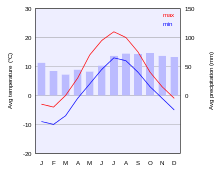
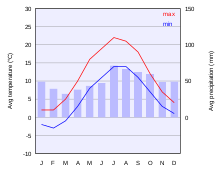
The Norwegian coast gets the most precipitation in all of Europe. While summer tends to be the wet season, weather can change fast around the year.
The further north, the greater is the variation of daylight between summer and winter. North of the Arctic circle, the Midnight Sun can be seen around midsummer, and Arctic night experienced in midwinter. In the far north in winter, the hours with even some daylight are few and precious; try to be outdoors before first sign of dawn. Oslo, Stockholm and Helsinki (around 60 degrees north) enjoy white nights in June, but only six hours of daylight in December.
Talk
Danish, Norwegian and Swedish are closely related and more or less mutually intelligible in their standard forms, especially in writing. As they are Germanic languages, there are many cognates of German and Dutch, and even English speakers will be able to recognise the odd word once they get their heads around the phonetic spelling: e.g. English school is Swedish skola and Danish/Norwegian skole, while first becomes först/først. Everyday words such as "open", "room", "bus" and "taxi" are virtually identical to English. Many grocery items also, for instance "bread" is "brød/bröd", "milk" is "melk/mjölk". Norwegian and Swedish are often (not all dialects) recognized by the use of pitch accent giving these languages a "singing" quality like Latvian and some South Slavic languages, but unlike most other European languages.
While a few archaic dialects are only understood by locals, virtually everyone speaks their country's standard national language, though in Norway there are only dialects and no standard spoken Norwegian. Both writing standards (Nynorsk and Bokmål) are approximations of different "average dialects" rather than the native tongue of any individual Norwegian.
While Icelandic and Faroese are also North Germanic languages, they have been in a linguistic freezer since the 13th century, and are largely unintelligible to other Germanic speakers, though many cognates will still be recognisable. Icelanders and Faroese learn Danish at school, and can in theory talk with their Scandinavian kinsmen in a Nordic tongue, though in practice, Danish proficiency tends to be limited among Icelanders. Nordic people who have regular contact with their neigbours usually also know how to adjust their speech into "Scandinavian" so that it is more easily understood by the others.
The real outliers are Finnish and Sámi, which belong to the Finno-Ugric family, and Greenlandic, which is Eskimo–Aleut. These are not Germanic or even Indo-European languages at all, making them considerably harder for speakers of most other European languages to learn. On the other hand, Finland has a roughly 5 % Swedish-speaking minority, and Finnish and Swedish have equal legal standing. Finnish speakers study Swedish at school and about 45 % are conversant in Swedish by adulthood. However, most Finns have better mastery of English than Swedish, while urban Swedish speakers usually are fluent in both. Finnish is quite closely related to Estonian, while Hungarian is distant enough not to help in intelligibility. The Sámi languages also belong to the Finno-Ugric family and Sámi is an official language in some municipalities of Lapland and Finnmark and also a recognized minority language in Sweden. The people of Åland speak Swedish (with widely varying proficiency in Finnish). In Greenland many are bilingual with Danish.
The Nordic countries have some of the highest levels of English proficiency among countries where English is not an official language. Public information (such as in public transport or government offices) is often printed in English in addition to the official language of the district. Tourist information is often printed in other languages as well, typically German or French.
Virtually everybody born since 1945 speaks at least basic English, and younger people tend to be fluent. Most students also study a third major European language, such as German, French and increasingly Spanish. Foreign language television programmes are usually shown in their original language with subtitles, with only children's programmes sometimes being dubbed into the local language, and even then DVDs and cinemas also offer the original language with subtitles.
The Nordic alphabets contain some special letters: å, ä/æ and ö/ø (the latter versions in Danish and Norwegian). In contrast to diacritic letters in many other languages, these are letters in their own right, ordered at the end of the alphabet; see the phrasebooks for details. Icelandic also contains the letter "þ", Icelandic and Faroese the letter "ð" – which used to exist in English and are now mostly represented by "th" in words that used to contain them – and both those languages use vowels with accents, which change the pronunciation of the letter. The Sámi languages also have letters of their own.
Get in
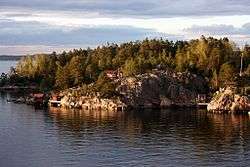
Most of the Nordic countries are part of the Schengen cooperation (exceptions include Greenland, the Faroe Islands and Svalbard), so residents of and visitors to EU can usually get here with little bureaucracy. Note that Iceland, Norway and the non-Schengen territories are not part of EU, so there is still a customs border here, too. There are also special requirements for those travelling with pets (some diseases common in central Europe are absent here).
By plane
Due to the large distances and the surrounding waters, air travel is often the most practical way to get into the Nordic countries. All the largest cities have international airports, and even towns like Haugesund and Ålesund have some international flights. Almost all European airlines serve at least one Nordic airport.
- SAS Scandinavian Airlines (Denmark, Norway, Sweden) is the flag carrier and dominant airline of Denmark, Norway and Sweden. Copenhagen Airport (CPH IATA) is the main hub, with secondary hubs in Stockholm-Arlanda and Oslo-Gardermoen.
- Finnair (Finland) is Finland's flag carrier, flying out from its main base in Helsinki, utilizing its eastern location for transit flights between Europe and Asia.
- Icelandair (Iceland) - Leverages on its strategic location midway between Europe and North America to maintain a strong presence on North American routes, with its main hub in Keflavík Airport (KEF IATA).
- Atlantic Airways (Faroe Islands) - Flies to many destinations in the North Atlantic, including Britain and Iceland, and their partner airline Air Iceland (Flugfélag Íslands) extends the North Atlantic network to include several destinations in Greenland.
- Norwegian(Scandinavia) is a budget carrier, which despite the name, does not just fly from Norway. It flies from Oslo, Stockholm and Copenhagen to Bangkok, Fort Lauderdale, New York, Las Vegas, Los Angeles, amongst other destinations
Besides these, many international airlines offer direct routes to the Nordic countries. Emirates, Gulf Air, Air Canada and Singapore Airlines fly to Copenhagen, Air China to Stockholm. Also PIA (Pakistan), Thai, Qatar Airways, American Airlines, Delta, and United Airlines all service several intercontinental routes to Scandinavia.
Alternative low cost airlines in the region include Norwegian in Norway, Sweden and Denmark. All three of these airlines have routes to one of the London airports, and hence London is a good entry point, if you can find a cheaper flight there, which is often the case. Many of the low cost airlines mainly serve routes between the colder Scandinavia and the sunny Mediterranean; hence you can also often find bargain flights from Spain, Italy, etc. should you wish to experience a real Nordic winter. Like most Icelandic airlines, Wow Air leverages its Keflavik hub into destinations on both sides of the Atlantic and they are one of a few airlines to offer transatlantic flights without meal or luggage included in the flight, following a low cost model.
By train
Denmark is well-connected to the German rail network. The direct connection to Copenhagen is, however, by the Puttgarden–Rødby ferry (a fixed link is due to open in the 2020s). Sweden is connected to Danish railways via the Øresund bridge between Copenhagen and Malmö, and to the German capital by a bi-daily sleeper train during the summer, bypassing Denmark via the Trelleborg–Rostock ferry – this is sadly the last of a once formidable network between Central Europe and Scandinavia, as the German railways has gotten out of the business. Finland has rail connection to Russia from St Petersburg and Moscow. For interrail pass holders most of the ferries crossing the Baltic and North seas offers discounts (25–50%), but only the Scandlines ferries are completely included in the pass (see By ferry section).
|
By ferry
- See also: Baltic Sea ferries
Norway is served by ferries from Denmark and Germany. To Sweden, there are ferries from Estonia, Latvia, Lithuania, and Poland. Iceland is connected to Denmark and the Faroe Islands by ferry. To Finland there are ferries from Estonia and Germany.
¹ About 1 hour south of Stockholm by suburban train
By car
Denmark is connected to the continental road network. From Denmark it is possible to cross to Sweden over the Öresund bridge (which is a toll road, see official site for prices – around €50 as of 2017). There are many ferry connections from Denmark to Sweden, most of them take cars. The only overland alternative to the Öresund bridge is to enter via Russia to Finland or Norway. Save a few short stretches of regular road, you can drive all the way to Stockholm or Oslo on highway from the German ones, but keep in mind that the tolls on the two Danish highway bridges you need to pass to get to Sweden are heavy, and you could save money and kilometers on your car taking a more direct route with a ferry. Virtually all Nordic roads are toll free, but some of the larger cities (most notably Stockholm and Gothenburg) have introduced congestion charges when driving in the centre, and some of the longer bridges and tunnels levy tolls to pay for their construction.
By yacht
- See also: Boating on the Baltic Sea
Iceland, the Faroes and Greenland are out in the Atlantic, so getting there requires some serious off-shore experience, but Denmark, Norway, Sweden and Finland are quite easily reached from the rest of northern Europe, e.g. Dutch and British vessels are regularly seen even in Finnish marinas. Norway is behind the North Sea for most visitors, but also reachable by the coast via Denmark or Sweden, while the Danish Straits and the Kiel Canal are the main options for visitors from the west to Finland or Sweden. The Baltic Sea is also reachable via inland waterways from most European countries.
The Nordic countries have a huge number of yachts compared to the population, so the infrastructure is good – and the archipelagos and fjords offer an endless coastline to explore.
Get around
By ferry
- See also: Baltic Sea ferries
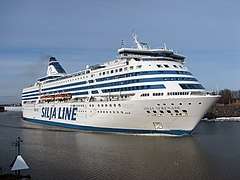
|
Baltic Sea cruises "Our level of drunkenness was normal for a cruise of this kind." The managing director of shipping company Tallink gave an interesting quote after his and the entire board's drunken rampage on one of Tallink's cruise ships in 2006. (The accusations against the VIP's included sexual harassment against female staff, beating up a bartender and causing a fire by putting a fish in a toaster.) The director's explanation clearly shows the main PR problem about the cruise ships on the Baltic Sea: they have a reputation as trashy booze boats, far from the glamour of other international cruises. This is largely due to the fact that the tickets can be dirt cheap – sometimes less than 50 SEK – and that tax-free alcohol shopping is among the main attractions. Still, some of the ships are really pretty, and it is an easy and cheap way to get a glimpse of a country on the other side of the Baltic Sea. Also, not all cruises include obnoxious drunks trying to toast fish. Stockholm is the main port in Sweden for the cruises, and the main destinations are Helsinki, Åland and Turku in Finland, Tallinn in Estonia and Riga in Latvia. Ships are operated by Viking Line, Tallink-Silja, Birka Cruises and MSC cruises. To get the cheapest tickets, try to go on a weekday in low season, share a four-bed cabin with some friends and make sure to keep your eyes peeled for last minute offers. |
Major coastal cities of the Baltic Sea are often connected with ferry lines, e.g. Turku–Stockholm and Helsinki–Tallinn, and ferries are a natural part of many journeys for Scandinavians. The larger long-distance ferries are in effect cruise ships, with behemoths like the Silja Europa featuring 13 decks stacked full of shops, restaurants, spas, saunas etc. Longer routes are nearly always scheduled to sail during the night, so you arrive fresh to continue the often long journeys required here. If you travel by ferry to Norway or pass through Åland, there are Tax Free sales on board, since Norway is not part of the EU and Åland is subject to special regulations. For the same reason some of these lines, especially the Stockholm–Helsinki ferries, are known as party boats – alcohol is heavily taxed on shore.
In addition to major lines listed below, the Hurtigruten ferries, running all along Norways amazing jagged coast line, and through spectacular fjords, from Bergen in the south to Kirkenes in the Arctic north, docking in many small hamlets and villages on the way, offer a unique and very Scandinavian experience. More than a hundred car ferries are an integral parts of Norway’s roads, most crossings are short and frequent.
Minor ferries connect many inhabited islands to the mainland in also the other archipelagos, and tour boats cruise e.g. the archipelagos of Stockholm and Helsinki, and lakes such as Päijänne and Saimaa.
| From | To | Operator |
| Copenhagen, (Denmark) | Oslo (Norway) | DFDS Seaways, 16.5 hr |
| Grenå, (Denmark) | Varberg, (Sweden) | Stena Line 4.5 hr |
| Frederikshavn, (Denmark) | Göteborg, (Sweden) | Stena Line 2-4 hr |
| Hirtshals, (Denmark) | Larvik, (Norway) | Colorline, 4 hr |
| Hirtshals, (Denmark) | Kristiansand, (Norway) | Colorline, 4 hr |
| Hirtshals, (Denmark) | Bergen, (Norway) | Fjordline, 19.5 hr (via Stavanger - 11.5 hr) |
| Hirtshals, (Denmark) | Seyðisfjörður, (Iceland) | Smyril line , 69 hr (via the Faroe Islands - 44 hr summer) |
| Hirtshals, (Denmark) | Tórshavn, (Faroe Islands) | Smyril line , 44 hr (winter) |
| Strömstad, (Sweden) | Sandefjord, (Norway) | Colorline, 2.5 hr |
| Stockholm, (Sweden) | Helsinki, (Finland) | Tallink Silja line & Viking line, 16.5 hr (via Åland islands) |
| Stockholm, (Sweden) | Turku, (Finland) | Tallink Silja line & Viking line, 11 hr (via Åland islands) |
| Umeå, (Sweden) | Vaasa, (Finland) | Wasaline, 3.5 hr |
By train
- See also: Rail travel in Europe
Trains are an adequate way of travelling around the Nordic countries, except the island nations and the far north. International connections between Denmark, southern Sweden and southern Norway are good, but up north services are sparse, and Iceland and the Faroe Islands have no trains at all. Norway’s rail network is limited and mostly centered on Oslo with lines to main cities in other parts of the country. Finnish railways use the Russian broad gauge, so while there are connecting rails, no regular passenger trains cross the border.
The previous night train connection between Copenhagen and Oslo has been retired, and this route now requires a change in Gothenburg, on the other hand day time connections have become much more frequent after the opening of the Øresund bridge (8.5 hr). Up to seven daily X2000 express trains run directly between Copenhagen and Stockholm (5.5 hr), and the daily night train only requires an easy change in Malmö (7.5 hr). Further north there are two daily connections between Oslo and Bodø (17 hr, via Trondheim) – the northernmost stop on the Norwegian railway network, and two daily night trains (regular and express) between Stockholm and Umeå/Luleå (16–20 hr) in the northernmost part of Sweden. The Norwegian port of Narvik is connected to the Swedish network via the impressive Iron Ore Railway through Kiruna, also served by passenger train. In Finland the daily night trains between Helsinki and Turku in the south and Rovaniemi (or Kolari) in the north also take cars.
The ScanRail pass was retired in 2007, but visitors not resident in Europe can opt for the very similar Eurail Scandinavia Pass, which offers 4 to 10 days of travel in a 2-month period for €232–361. For residents of Europe, the all-Europe or single-country Interrail passes are also an option.
Major railway companies in Scandinavian include DSB and Arriva in Denmark, NSB in Norway, SJ, Transdev in Sweden and VR in Finland.
By bus
If you are not using a rail pass, long distance buses will often be a cheaper alternative, especially for longer journeys. Bus is also needed to get to many smaller towns or the countryside. Since highways are almost exclusively centred around the southern half of Scandinavia, journeys become increasingly time consuming as you get further north. On the other hand, rail services also get increasingly sparse in northern Scandinavia.
There is no dominant company like Greyhound is in North America or Flixbus is in Germany, but a host of local, regional and national bus companies. The major national intercity bus companies are Abildskou in Denmark, Nor-Way and Nettbuss in Norway. Big companies also include GoByBus, Eurolines and Swebus, which all service routes in the Scandinavian triangle between Copenhagen, Oslo and Stockholm. In Finland there are many regional companies, but timetables and tickets to nearly all lines can be obtained through Matkahuolto. Onnibus, which provides cheaper services on many intercity routes, does not participate in that cooperation.
By car
- See also: Driving in Sweden, Driving in Norway, Driving in Iceland

Driving in the Nordic countries is costly, even by European standards. Rentals are often expensive, fuel price is among the world's highest, and distances are long. In Norway, in particular, distances that seem short on a map can be very long and tiring if you need to drive along twisty fjord roads. Collisions with wildlife, particularly moose, deer and, mostly north of the Arctic circle, reindeer, are quite common and can be fatal. On the other hand, roads are generally in good condition, traffic is disciplined, and per capita fatalities are among the lowest in the world, for instance the US has four times higher accident rates than Norway (per 2017) ̣—̣ Norway and Sweden are aiming for zero fatalities.
From November until March (and well into May in the northern regions), expect winter driving conditions and have proper equipment – particularly winter tyres, as roads are treacherously slippery. People will drive nearly as in summer, so with summer tyres you will either block the traffic or cause an accident. Nordic type winter tyres (studded or unstudded) are the best, although other types with enough tread depth are permitted. Black ice in the morning and occasional snowfall are possible also quite early in the autumn, and then mess up traffic worse than in winter, as not everybody is prepared. Leave your car alone such days (many locals who had not yet switched to winter tyres do), at least in the morning, until things have settled, especially if you were not prepared for winter driving. Studded tyres are allowed from November to sometimes in April, except in some parts of a few city centres.
Speed limits are reduced in winter on some major roads, but not enough for bad conditions; you and your travel mates can get seriously injured if you drive ill prepared or too fast. Study the regulations carefully; you can get fined for not having winter tyres in some countries in certain periods and conditions and driving with studded tyres might either cost you a fee or be limited to certain periods:
- In Denmark studded tyres are allowed from 1 November to 15 April.
- In Finland studded tyres are allowed from 1 November to one week after Easter, and otherwise with good reason (i.e. icy or snowy roads expected here or at the destination). Winter tyres are mandatory from 1 December through the end of February.
- In Iceland studded tyres are allowed from November to April.
- In Norway studded tyres are allowed from 1 November; there is a fee for using studded in cities: 30 NOK per day. Winter tyres are mandatory November–April.
- In Sweden winter tyres are mandatory in winter conditions from 1 December to 31 March (for cars registered in Sweden; foreign cars with summer tyres are not allowed to drive in bad conditions). Driving with studded tyres is forbidden in certain streets.
Speed limits are uniform; 50kph in cities and 80kph (70kph in Sweden) on rural roads unless otherwise indicated. Motorways range from 100 in Norway (only when signposted, otherwise 80), 110 in Sweden, 120 in Finland to 130 in Denmark, again unless other speed limits are signposted. Keep in mind that while many Scandinavians routinely exceed speed limits, fines are heavy and if you don't benefit from the high Scandinavian wages, they will feel even more steep, so you will in essence probably be gambling with your holiday budget. Speeding in city zones is considered a severe offence, and there are many unmarked automatic speed traps installed in such zones.
Some main routes are the E75 (Highway 4, "Nelostie") through Finland, the E4 through Sweden, the E6 through Sweden and Norway ("Eseksen"), the E10 through Sweden and Norway, and the E45 through Denmark and Sweden.
By boat
- See also: Boating on the Baltic Sea
There is a boat for every seventh person in each of Finland, Norway and Sweden, so facilities for yachts as well as availability of boats, through a local friend or by rent or charter, are good. These countries also have a large number of lakes with ample opportunities for boat trips. Norway's coastline is around 100,000 km when fjords and islands are included, and there are more than 100,000 islands, offering endless opportunity for sailing in sheltered waters. Figures are similar in the other two of these countries. The sea is important also for Denmark, Faroe Icelands, Greenland and Iceland.
By thumb
Hitchhiking is not too common in the Nordic countries. In some regions it is quite easy to get a ride – once there comes a vehicle – in others only a small fraction of cars take hitchhikers. If trying to hitchhike in autumn or winter, remember it can get quite cold, and hours with daylight are limited. There are large sparsely inhabited areas; avoid having a ride end in the middle of nowhere in the evening, unless you are prepared to stay the night there. In addition to the normal places, it is possible to approach drivers on ferries and ask for a ride.
By bike
Bicycle infrastructure varies from country to country and from town to town, but is generally at least decent.
Helmet, light(s) (at least from August), reflectors and lock are mandatory or strongly advised.
The best developed bicycle infrastructure is in Denmark (see Cycling in Denmark), where bike lanes are ubiquitous in cities and common also in the countryside, with a good network of routes. In the other countries there are usually some kind of bike lane network in the cities, but the routes may not be obvious or complete, and they are not always maintained in winter. The main roads outside of towns do not always have bike lanes or usable shoulders, and not all drivers are careful when passing by.
It is usually easy to find places to rent a bike, and municipal short-time rental systems have been introduced in some cities.
It is usually possible to take the bike on coaches and trains for moderate fees, which is recommended for most to do on some stretches because of the long distances. In Sweden only folding bikes can be taken on trains. Short-haul ferries are often free or nearly free for cyclists, Baltic ferries take a small surcharge. In general the price for a cyclist will be the same as for a "pedestrian" or slightly higher, and much lower than for hauling around a ton of metal box.
In Finland and Sweden there are often minor roads that make good routes for long-distance cycling, provided you have a map allowing you to navigate them. Most cities have decent bike lane networks.
In Iceland there are few bike lanes outside Reykjavik, but cycling is quite safe because of low traffic (except on the roads out of Reykjavik). The weather and the distances between towns can be challenging.
In Norway cycling is popular and a fine way to see the varied landscape. The mountainous landscape, often quite narrow roads and sometimes less respectful drivers makes cycling a challenge. Some main roads and mountain passes have 7 to 10 % slopes. In many areas there is only one road and no alternative local road. Also here there are some old roads usable as (or transformed to) cycling routes. Following major roads, check whether bikes are allowed in the tunnels. Even if cycling is allowed in a tunnel, it is often uncomfortable. Norway has many subsea tunnels and these are often steep. Bike lanes are not too common, even in towns, but speeds are usually quite low.
There are a couple of EuroVelo cycling routes through the countries (mostly developed but not yet signed):
- 1) The Atlantic Coast Route from Nordkapp southwards along the coast
- 3) The Pilgrim Route from Trondheim towards Santiago de Compostela
- 7) The Sun Route from midnight sun of Nordkapp through Sweden towards Malta
- 10) Baltic Sea Cycle Route (Hansa circuit) around the coasts of the Baltic Sea
- 11) East Europe Route from Nordkapp through Finland towards Athens
- 12) North Sea Cycle Route from the British islands with ferry and to Germany by the coasts
- 13) The Iron Curtain Trail from the Barents Sea and Kirkenes along the Russian border in Finland and via St. Petersburg towards the Black Sea
See
There is a constant and long-standing rivalry between Copenhagen and Stockholm over which city can claim the title as Scandinavia's unofficial capital. Depending on how you count, both cities are the largest, most visited, and the target of most investment. However, after the completion of the Øresund bridge, and subsequent integration of Copenhagen and Malmö – Sweden's third largest city – this region is fast emerging as the main urban centre in Scandinavia, while Stockholm arguably grabs the title as the most beautiful.
- Visit the unusual free city of Christiania in Copenhagen
- Visit the famous Tivoli Gardens theme park in Copenhagen
- See the amazing Vasa Museum in Stockholm, displaying an entire flagship that sunk in the harbour nearly 400 years ago
Sceneries
|
King of the woods
|
While the fjords of Norway might be the most spectacular Nordic sceneries, the other countries have their fair share of beautiful nature as well, e.g. the Stockholm archipelago and the Archipelago Sea in the Baltic Sea, the thousand lakes of Finland (and quite some in Sweden), quiet forests and wide open landscapes of Iceland and of the north.
The Nordic countries also give opportunities to see Eurasian wildlife.
Northern Lights
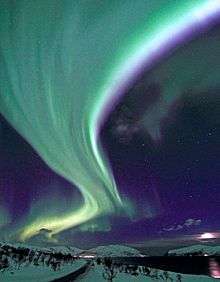
The Northern Lights (Latin: Aurora Borealis; Scandinavian: Nordlys/-ljus; Swedish: Norrsken; Finnish: Revontulet) can be seen at Arctic latitudes, and at rare occasions as far south as in Denmark. With a bit of bad luck they are obscured by clouds, so take local weather (and light pollution) into account if planning to watch for them.
Viking heritage
- See also: Vikings and the Old Norse
Before AD 1000 Norse people only wrote short rune carvings, and most literature about the Viking Age was either authored by the Viking's enemies, or written down centuries later. Since most of their buildings have perished, the Viking Age is shrouded in mystery. Still, Denmark, Iceland, Norway, and Sweden all have archaeological sites and Viking-themed museums.
While traces from the Viking Age are of modest size, they are numerous, especially runestones and burial mounds, everywhere in Scandinavia. Some good places to see Viking age artifacts are the Swedish History Museum ("Historiska museet") in Stockholm, Birka in Ekerö, the Settlement Exhibition Reykjavík 871±2 of the Reykjavik City Museum ("Minjasafn Reykjavíkur") in Reykjavik, the Viking Ship Museum ("Vikingeskibsmuseet") in Roskilde, Viking Ship Museum in Oslo, and Old Uppsala in Uppsala.
Royal Scandinavia
Denmark, Sweden, and Norway are all monarchies, although the royal families only have a ceremonial role. They remain part of society and are, more or less, popular among the population. They remain public figures often portrayed in the media and taking part in all sorts of events. Where ever they will show up, something interesting is likely going on. But more importantly, royal palaces and mansions are dotted throughout the region and make for some quality sightseeing, and knowing they are actual homes of some of the longest, continuously running royal families in the world just makes it better.
Nordic design
Scandinavia is famous for its design and architecture, which are often characterised by a minimal and functional approach. Copenhagen and Helsinki are the best places to experience it with some excellent, interactive museums and some live samples throughout the streets. Actually, the design and architecture are some of the strongest, most important assets of these cities, but there are interesting opportunities elsewhere as well.
Sami culture
The northern parts of Norway, Sweden and Finland are home to the Sami, an indigenous people.
Fiction tourism
- Astrid Lindgren tourism: Astrid Lindgren is one of the world's most read children's authors. Most of her books, and their motion picture adaptations, are set in Sweden.
- Hans Christian Andersen, a Danish writer famous for his fairy tales such as The Ugly Duckling and the Little Mermaid.
- Nordic Noir: Nordic crime fiction is acclaimed for its melancholic spirit, with titles such as Millennium, The Bridge, Pusher, and Wallander.
- Tove Jansson: there is a Moomin theme park in Naantali and a Tove Jansson museum in Tampere. Her summer cottage is in the outer archipelago of Porvoo (open for small groups one week yearly).
Itineraries
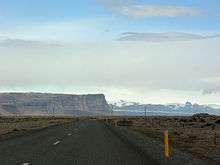
- Archipelago Trail, a route around the Archipelago Sea, using the inter-island ferries
- Finland in ten days by car, suggested route showing some of the most important sights in Finland
- Helsinki itineraries, suggested itineraries for stays of different length
- Hurtigruten, steamer along the Norwegian coast
- King's Road (Finland), a historic road through cultural landscapes with long traditions along Finland's southern coast
- Kungsleden, popular hiking trail in Sweden
- Nordkalottleden, hiking trail through Arctic Finland, Norway and Sweden
- Route 1-Ring Road, around Iceland
Do
- See also: Winter in the Nordic countries – also for events in Advent etc.
The great outdoors
The sparse population and the right to access makes the Nordic countries a great place for outdoor life.
- Go hiking and foraging in endless taiga forests, in fells and (in Norway) in alpine mountains.
- Cruise a Norwegian fjord, Geirangerfjord is a world-famous beauty while Sognefjord is the largest.
- Cruise the endless Norwegian coast with myriads of islands and wild cliffs.
- Cruise around the thousands of scenic islands in the Swedish and Finnish archipelago, e.g. the Archipelago Sea.
- Winter sport, such as Downhill skiing or snowboarding in some of Europe's most civilized and family friendly ski resorts.
- Go cross country skiing
Saunas
- Go skinny dipping from a sauna in the Land of a Thousand Lakes (Finland), with winter swimming for the boldest
Music acts
- See also: Nordic music
The Nordic countries have a tradition of music across several genres, with church choirs in seemingly every parish, classical composers such as Edvard Grieg and Jean Sibelius, pop music acts such as ABBA, Björk and Swedish House Mafia, as well as a dominance of the heavy-metal scene. The countries, in particular Denmark, are known for its many music festivals during the summer months. The largest in each country are:
- Roskilde Festival (Denmark, early July). One of the worlds most famous rock festivals, with 70,000 tickets for sale and 30,000 volunteers.
- Skanderborg Festival (Denmark, mid August). Second biggest festival in Denmark. A beautiful setting in a forest area hosting many Danish as well as international names. Roughly 50,000 tickets for sale.
- Ruisrock (Finland, July). Finland's largest music festival, held on an island in Turku, with around 70,000 spectators.
- Sweden Rock Festival (Sweden, June). Sweden's main heavy rock festival, takes place in southern Sweden and has an attendance of ~33,000.
- Øya (Norway, August). Norway's main rock festival although deliberately intimate; located centrally in an Oslo park and using the whole city as a stage in the night.
- Hove (Norway, June-July). Hove Festival mixes large international acts with Norwegian bands in the unique setting of an island outside Arendal city. 50,000 tickets sold.
- G! Festival (Faroe Islands, July). The Faroes' main (and arguably only) event, with around 10,000 participants and 6,000 tickets sold every year. Mainly local and Scandinavian bands.
- Iceland Airwaves (Iceland, October). A progressive, trendsetting, music festival that attracts around 2000 visitors every year, besides the many locals showing up.
Buy
As of the 2010s, the Nordic countries are known for being expensive for tourists, particularly when it comes to services, renting a car, eating out, taxis, alcohol and tobacco, in some ways even more so than major world cities like Tokyo, Hong Kong, New York City and London. Prices also vary between countries, with Norway and Iceland in particular being more expensive than the other Nordic countries. That said, there's plenty of nature and wildlife that's free. Many public museums and galleries have moderately priced tickets or are free of charge. Public transport is often moderately priced at least if various discounts are taken into account. Students and seniors are often entitled to 50% discounts on some public transport and in museums, while children up to 6–11 years are often for free. The Nordic countries have a fine selection of architecture (entrance to public buildings is often free of charge) and outdoor sculptures. Luxury items may even be cheaper the Nordic countries than elsewhere. Tipping is not expected, as menus and bills include taxes and service.
Finland is the only Nordic country which uses the Euro. Denmark's currency is pegged to the Euro within a narrow band.
Iceland, Norway, Denmark and Sweden each has a national currency, all known as krona or krone (plural krónur/kronor/kroner), often shortened kr. The centessimal subdivision is øre, although only Denmark has coins smaller than 1 kr; bills are rounded when paid in cash (so "kr 1,95" means 2 kr in practice). The national currencies are distinguished by the initials DKK, ISK, NOK and SEK.
Outside currencies are generally not accepted, except in border towns. Euro may be taken in some shops in the cities. ATMs are common in cities. Most establishments accept credit cards (at least VISA and Mastercard) so carrying large amounts of cash is unnecessary; in fact, a few establishments only accept payment cards and not cash.
Some suggested shopping items are traditional handicraft, and modern Nordic design. Neither is cheap, though.
Eat
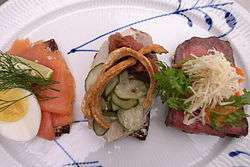
- See also: Nordic cuisine
The cuisines of all Scandinavian countries are quite similar, although each country does have its signature dishes. Seafood features prominently on restaurant menus, although beef, pork and chicken are more common in many everyday dishes. Potatoes are the main staple, most often simply boiled, but also made into mashed potatoes, potato salad and more. Spices are used sparingly, but fresh herbs are used to accentuate the ingredients.
Famous pan-Scandinavian dishes include:
- Herring, especially pickled
- Meatballs, served with potatoes, berries and creamy sauce
- Salmon, especially smoked or salt-cured (gravlax)
- Smörgåsbord, a popular lunch option with bread, herring, smoked fish, cold cuts and more
Bread comes in dozens of varieties, with dark, heavy rye bread a specialty, and Scandinavian pastries are so well known that the word "danish" has even been imported into English.
Although derived from German sausages, the hot dog has been adapted for local tastes, with Norway, Denmark, Sweden and Iceland each having their own unique national styles. Danish røde pølser in particular are seen as an important part of national culture and cuisine.
Lately there has been a focus on revitalizing the "Nordic kitchen" by focusing on local produce and generally raising the quality of gastronomy in the region, often coined as New Nordic Cuisine. This is influencing both everyday cooking as well as fine dining. As a result, especially Copenhagen and Stockholm have seen the development of excellent high end restaurants, including NOMA which has been awarded the best in the world 3 years in a row.
As in most of Europe, internationalized fast food and ethnic cuisines are popular in major Scandinavian cities. Especially Denmark and Sweden have many Middle Eastern, Chinese and other Asian diners. Norway has a large number of Asian cafés and restaurants.
Awareness about dietary restrictions is high, at least in big cities. Most restaurants have vegetarian options, although often not very special. Good vegetarian restaurants are found in many cities. Halal meat is more difficult to find in mainstream establishments.
Drink
Vikings were famously heavy drinkers, and despite continuing government efforts to stamp out the demon drink through heavy taxation, today's Scandinavians continue the tradition. Bring in your full tax-free allowance if you plan to indulge, since in Norway you can expect to pay up to 60 NOK (7€) for a pint of beer in a pub, and Sweden and Finland are not far behind. Alcohol in Denmark is significantly cheaper, although still more expensive than elsewhere in Europe. To reduce the pain, it is common to start drinking at home before heading out to party. The drinking age is generally 18 (20 in Iceland), but many bars and clubs have their own higher age limits.
Denmark is the only Nordic country where stronger alcoholic beverages can be bought in supermarkets. The other countries restrict retailing (excepts restaurants and bars) to government-operated stores. Vinmonopolet in Norway, Vinbuđin on Iceland, Systembolaget in Sweden and Alko in Finland. Age limits and closing hours are strict.
The main tipples are beer and vodka-like distilled spirits called brännvin, including herb-flavored akvavit. Spirits are typically drunk as snaps or ice-cold from shot glasses.
Sleep
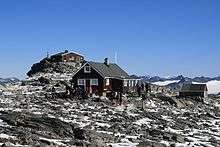
As expected, hotels are quite expensive. Some money can be saved by timing (business hotels are cheaper in the weekends etc.), but it may be worthwhile to check other options.
In the countryside, hotels are sparse except at resorts, but there are usually guesthouses or similar instead, often very nice. Another option (at resorts and in the countryside) is a cottage, some of them very reasonably priced for a group, at least off season – but check what to expect, the facilities vary wildly.
With so much incredible nature outside the doorstep, it should be no surprise that the Scandinavian countries have a well developed hostel network, named Vandrerhjem/Vandrarhem in the Scandinavian languages – literally translating into "wanderers' home" or "hikers' home". While the rules are often quite strict, it is much cheaper than hotels, and with almost 800 hostels available, you can often find one. The respective national organisations are called Danhostel in Denmark, STF or SVIF in Sweden, Norske Vandrerhjem in Norway, SRM in Finland and finally Farfuglar in Iceland.
Throughout Scandinavia, with exception of densely populated Denmark, Allemansrätten, or "Every Man's Right" in English, is an important underpinning of society, and guarantees everyone the right to stay or camp on any uncultivated land for one or two nights, as long as you respect certain norms, stay out of sight of any residents, and leave no traces of your visit when you leave. If you enjoy the great outdoors, this can help make the otherwise expensive Scandinavian countries, become quite affordable. In national parks and similar, and in the Norwegian mountains, there are also wilderness huts, with price of lodging varying from free (open wilderness huts in Finland) to cheap or reasonable (Iceland, Norway and Sweden, reservation huts in Finland)
Car camping (or just camping) can be an economic option; there are camping sites also near many cities.
In cottages and hostels you are often supposed to bring your own linen, with linen provided for a fee otherwise, or in some cases, like some wilderness huts, not provided at all. If using primitive facilities, a sleeping bag may be handy or even needed. Sleeping bags for summer use are often enough also when camping in season (and not much too warm indoors), but night temperatures close to freezing are possible most of the year; early and late in the season, and in the north and the mountains, a three-season sleeping bag can be a good choice.
Work
The Nordic countries are in EEA and thus fully participate in the free movement of labour, so EU citizens can take jobs on basically the same conditions as locals. While English is good enough for some types of jobs, most careers require fluency in the national language. Language is less of a barrier for intra-Nordic migrants, as Swedish, Norwegian and Danish are mutually intelligible, and many Icelanders and Finns speak one of those languages.
The Nordjobb is a scheme for summer jobs (with housing and activities) for the youth. Proficiency in Danish, Norwegian or Swedish and Nordic or EEA citizenship is required.
Salaries tend to be high but so are taxes. Of course those taxes pay for a lot of social and health care programs and working while raising small children is made easier by generous pro-family policies and childcare institutions.
Stay safe
- See also: Winter in the Nordic countries
Crime rate is generally low, but use common sense to avoid drunk brawls, vandalism, and pickpocketing, especially in large cities. The Nordic countries are usually ranked as the world's least corrupt countries.
Cold weather is a major risk factor during the winter; and year round in highland and Arctic areas. Hypothermia can occur well above freezing if there is wind or rain, and is a risk factor particularly when you cannot get indoors, such as when hiking. There may be a similar problem in particularly cold weather in cities at night, if you get lost or cannot find a taxi, but you seldom have to endure such a situation for several hours.
For daytime activities in cities and towns, the cold is hardly dangerous, as you can get indoors if need be, but adequate clothing allows you to enjoy the winter weather – and in severe cold you'd easily find yourself confined to indoor activities if your clothing is deficient.
Stay healthy
In Denmark, Finland, Iceland (despite the volcanic smell), Norway and Sweden the tap water is mostly of very good quality, often better than bottled water. Where the tap water is not safe (such as on trains), you can expect there to be a warning. Also, good-looking water from streams is good in many areas. In important ground water areas there may be restrictions on swimming, et al.
Respect
| “ | Att komma i tid är att komma för sent. "Showing up on time, is showing up too late." |
” |
—Attributed to a Swedish drill officer. | ||
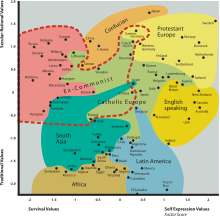
Nordic people are generally cosmopolitan and secular. They have some virtues in common:
- Equality: treat people equally, regardless of their gender or title.
- Modesty: bragging, or showing off wealth, is not popular.
- Punctuality: show up on the minute for appointments and business meetings. Showing up five to ten minutes before set time is good manners.
- Privacy: Nordic people have a justified reputation of needing much personal space, and avoiding small talk with strangers in public spaces. Shop assistants and other service workers can be perceived as unattentive.
Tobacco smoking is prohibited at indoor venues in all countries. Rather few Nordic people smoke; instead smokeless tobacco such as snus is widely used. While sober at work and behind the steering wheel, binge-drinking alcohol during weekends is not uncommon, with a risk of drunk brawls.
Despite the liberal image of the Nordic countries, narcotics including cannabis are taboo among most, young as well as old, and treated with zero tolerance by the police. Possession of even personal use amounts is criminalized in all five countries. Denmark, long more liberal than the rest, has also taken a harder line in recent years and tried to fight the drug dealing in Christiania, but attempts by the police to get inside of the area failed, and were met with harsh resistance from the people within that area. The area still stands, and is known as the part of Copenhagen where drugs are easily accessible.
The political reputation of a society where everybody is taken care of seems at times hard to reconcile with the way in which Nordic people tend to be distant and reserved towards strangers. Keep your distance and others won't bother you, either. While reserved, if asked for help people in the Nordic area tend to be sincere and helpful, even more so in the countryside and in the wilderness. The idea that the government should provide for the needy makes people more reluctant to offer help themselves where help is not needed on the spot.
Nordic people might be reluctant to give favours and gifts to strangers or new acquaintances. Receiving a gift of more than token value could feel like a burden for Nordic people, who value independence. At a restaurant, the norm is that everybody pays their own food and drinks (although when inviting somebody to a restaurant this rule is not clear, and a man inviting a woman for a romantic dinner could upset her either way, depending on her and on the circumstances).
The Nordic reputation to have relaxed view of nudity and sexuality is only partly true. Nordic people accept homosexual and cross-gender expressions. When it comes to public breastfeeding; if adults are allowed to eat somewhere, babies are as well. However, skinny-dipping (toddlers aside) is only accepted in private communities, at designated nudist beaches or in the remote wilderness. Public nudity is not forbidden, but "indecent" behaviour is, that is, if you are likely to offend (and the judgement call is difficult for a foreigner). In Sweden, Norway and on Iceland, hiring a prostitute is criminalized (and also in Finland, if they are victim of trafficking), and while pornography is legal (including strip clubs), it is taboo.
Hunting and wildlife management are sensitive topics, where countryside-dwellers tend to have strong opinions, especially for or against the bear and wolf population. Norway and Iceland are among the few countries which allow the controversial practice of whaling.
Nordic people prefer to greet new acquaintances with a handshake; they might be hugging close friends. While cheek-kissing is not unheard of, most Nordic people find it confusing.
While political relations between the Nordic countries are good, many Nordic people are patriotic — not least the Norwegians and Finns, who have fought hard for their independence in modern times. Visitors should recognise the unique character of the country they are in. Due to the friendly rivalry between the countries, many appreciate any comments about their own country being better than their neighbours.
In each country, Lutheranism is either the state religion, or has privileged status. Nevertheless, in practice they are rather secular in daily life, and people who go to church regularly are the exception rather than the rule. In general, Nordic people are tolerant towards people of all faiths, though attempts to proselytise are not welcome.
